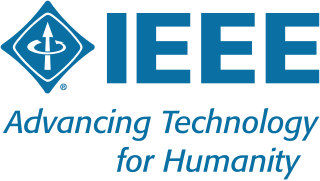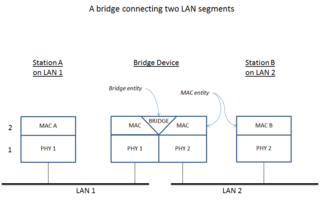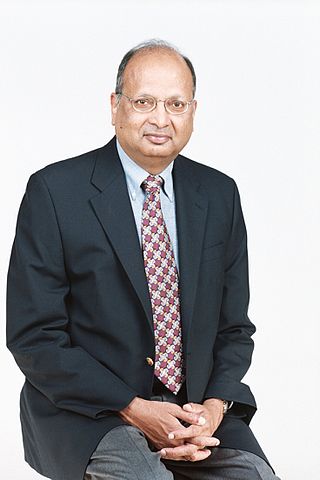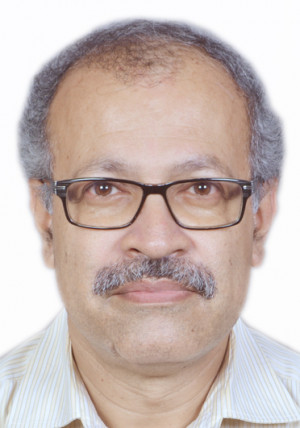
The Institute of Electrical and Electronics Engineers (IEEE) is an American 501(c)(3) professional association for electronics engineering, electrical engineering, and other related disciplines.

John Leroy Hennessy is an American computer scientist who is chairperson of Alphabet Inc. (Google). Hennessy is one of the founders of MIPS Technologies and Atheros, and also the tenth President of Stanford University. Hennessy announced that he would step down in the summer of 2016. He was succeeded as president by Marc Tessier-Lavigne. Marc Andreessen called him "the godfather of Silicon Valley."

Ethernet flow control is a mechanism for temporarily stopping the transmission of data on Ethernet family computer networks. The goal of this mechanism is to avoid packet loss in the presence of network congestion.

A network bridge is a computer networking device that creates a single, aggregate network from multiple communication networks or network segments. This function is called network bridging. Bridging is distinct from routing. Routing allows multiple networks to communicate independently and yet remain separate, whereas bridging connects two separate networks as if they were a single network. In the OSI model, bridging is performed in the data link layer. If one or more segments of the bridged network are wireless, the device is known as a wireless bridge.
Stephen Deering is a former Fellow at Cisco Systems, where he worked on the development and standardization of architectural enhancements to the Internet Protocol. Prior to joining Cisco in 1996, he spent six years at Xerox's Palo Alto Research Center, engaged in research on advanced Internet technologies, including multicast routing, mobile internetworking, scalable addressing, and support for multimedia applications over the Internet. He is a former member of the Internet Architecture Board, a past chair of numerous Working Groups of the Internet Engineering Task Force (IETF), the inventor of IP multicast, and the lead designer of the new version of the Internet Protocol, IPv6. By 2017 he was retired and living in Vancouver, British Columbia.

The physical-layer specifications of the Ethernet family of computer network standards are published by the Institute of Electrical and Electronics Engineers (IEEE), which defines the electrical or optical properties and the transfer speed of the physical connection between a device and the network or between network devices. It is complemented by the MAC layer and the logical link layer. An implementation of a specific physical layer is commonly referred to as PHY.
40 Gigabit Ethernet (40GbE) and 100 Gigabit Ethernet (100GbE) are groups of computer networking technologies for transmitting Ethernet frames at rates of 40 and 100 gigabits per second (Gbit/s), respectively. These technologies offer significantly higher speeds than 10 Gigabit Ethernet. The technology was first defined by the IEEE 802.3ba-2010 standard and later by the 802.3bg-2011, 802.3bj-2014, 802.3bm-2015, and 802.3cd-2018 standards. The first succeeding Terabit Ethernet specifications were approved in 2017.

Arogyaswami J. Paulraj is an Indian-American electrical engineer, academic. He is a Professor Emeritus (Research) in the Department of Electrical Engineering at Stanford University.

Nicholas (Nick) William McKeown FREng, is a Senior Fellow at Intel, a professor in the Electrical Engineering and Computer Science departments at Stanford University, and a visiting professor at Oxford University. He has also started technology companies in Silicon Valley.
Neil H. E. Weste, is an Australian inventor and engineer, noted for having designed a 2-chip wireless LAN implementation and for authoring the textbook Principles of CMOS VLSI Design. He has worked in many aspects of integrated-circuit design and was a co-founder of Radiata Communications.
David Skellern is an Australian electronic engineer and computer scientist credited, along with colleagues, for the first chip-set implementation of the IEEE 802.11a wireless networking standard.
Mangalore Anantha Pai was an Indian electrical engineer, academic and a professor emeritus at the University of Illinois at Urbana–Champaign. A former professor of electrical engineering at the Indian Institute of Technology, Kanpur, he is known for his contributions in the fields of power stability, power grids, large scale power system analysis, system security and optimal control of nuclear reactors and he has published 8 books and several articles. Pai is the first India-born scientist to be awarded a PhD in electrical engineering from the University of California, Berkeley.

Soumitro Banerjee is an Indian electrical engineer and former director of the Indian Institute of Science Education and Research, Kolkata. He is known for his studies on bifurcation phenomena in power electronic circuits and is an elected fellow of all three major Indian science academies: the National Academy of Sciences, India, Indian Academy of Sciences, and Indian National Science Academy. He is also a fellow of The World Academy of Sciences, Institute of Electrical and Electronics Engineers, West Bengal Academy of Sciences and the Indian National Academy of Engineering. The Council of Scientific and Industrial Research, the apex agency of the Government of India for scientific research, awarded him the Shanti Swarup Bhatnagar Prize for Science and Technology, one of the highest Indian science awards for his contributions to Engineering Sciences in 2003.
Ranjan Kumar Mallik is an Indian electrical and communications engineer and a professor at the Department of Electrical Engineering of the Indian Institute of Technology, Delhi. He held the Jai Gupta Chair at IIT Delhi from 2007 to 2012 and the Brigadier Bhopinder Singh Chair from 2012 to 2017. He is known for his researches on multiple-input multi-output systems and is an elected fellow of all the three major Indian science academies viz. Indian Academy of Sciences, Indian National Science Academy, and The National Academy of Sciences, India. He is also an elected fellow of The World Academy of Sciences, Indian National Academy of Engineering, and The Institute of Electrical and Electronics Engineers, Inc.
Yendluri Shanthi Pavan is an Indian electrical engineer and a professor at the Department of Electrical Engineering of the Indian Institute of Technology, Madras. He is known for his studies on mixed signal VLSI circuits and is an elected fellow of the Indian National Academy of Engineering. He is also a fellow of IEEE. The Council of Scientific and Industrial Research, the apex agency of the Government of India for scientific research, awarded him the Shanti Swarup Bhatnagar Prize for Science and Technology, one of the highest Indian science awards for his contributions to Engineering Sciences in 2012.
Shigang Chen from the University of Florida in Gainesville was named Fellow of the Institute of Electrical and Electronics Engineers (IEEE) in 2016 for contributions to quality of service provisioning and policy-based security management in computer networks.
Brice Achkir from the Cisco Systems, Inc., San Jose, CA was named Fellow of the Institute of Electrical and Electronics Engineers (IEEE) in 2014 for contributions to diagnostics of physical layer design in gigabit digital transmission systems.
William Eric Eklow is an electrical engineer with Cisco Systems, Inc. He was named a Fellow of the Institute of Electrical and Electronics Engineers (IEEE) in 2012 for his work in test technology for printed circuit assemblies and systems.
James F. Gibbons is an American electrical engineer and academic administrator. He is credited with starting the semiconductor device fabrication laboratory at Stanford University that enabled the semiconductor industry and created Silicon Valley.
Vishal Misra is an Indian-American scientist at Columbia University, New York, NY and known for his numerous contributions to Computer Networking. He was named Fellow of the Institute of Electrical and Electronics Engineers (IEEE) in 2016 for contributions to network traffic modeling, congestion control and Internet economics. He was elected as an ACM Fellow in 2018. In 2019, he was designated a Distinguished Alumnus of IIT Bombay, from which he graduated in 1992.







